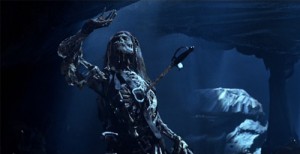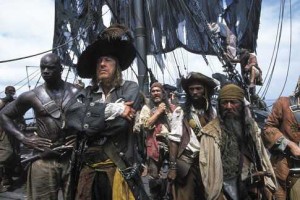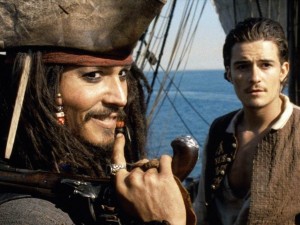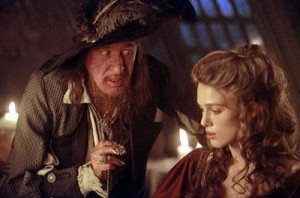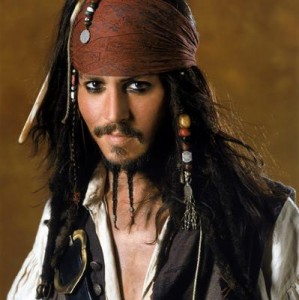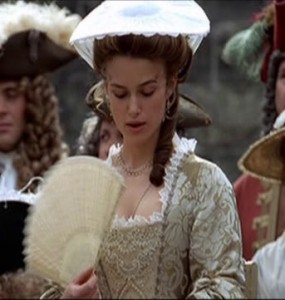A note on Wreck-it Ralph
Congratulations to the Disney Animation folks on their brand-new hit. It is charming, witty, funny and entertaining.
Noteworthy to me is Ralph’s in-game backstory. It’s not really a spoiler, since it’s not really discussed at length in the movie, but I will hide it under the fold nevertheless for the sake of decency.
Pirates of the Caribbean: The Curse of the Black Pearl part 4
As Act IV of Curse begins, Will Turner is locked up in the brig aboard the Black Pearl. He talks to Pintel about his father, Bootstrap Bill. Pintel informs Will, and the audience, that Bootstrap Bill wasn’t an evil pirate like Barbossa, that he “felt bad” about mutinying against Jack. He goes on to tell Will that Bootstrap Bill sent the cursed gold piece to Will in order to remain deliberately cursed. If that’s true, well, good going Bootstrap Bill, now your son is set to die at the hands of your cursed pirate friends. Finally, Pintel tells Will that Barbossa killed Bootstrap Bill for sending the gold piece to Will. Phew! I don’t think I’ve ever come across a smaller maguffin more responsible for more plot before, and the movie still has a half-hour to go.
Pirates of the Caribbean: Curse of the Black Pearl part 3
At the top of Act III of Curse, Elizabeth has been rescued from the clutches of bad-pirate Barbossa, by declared non-pirate Will Turner (at the top of Act III Will declares, twice in ten seconds, his non-pirate status). Since Elizabeths’ goal is for Will to be a pirate, she still faces an uphill battle. As Will tenderly goes to cop a feel off Elizabeth’s breast, she takes out the medallion that started all this craziness, the one she took off Will that day so many years ago. In the traditional fairy tale, the boy-prince is given a medallion that will one day prove he is royalty — here, the screenwriters have stood the tradition on its head and given the boy a medallion that proves he is a criminal.
Read more
Pirates of the Caribbean: The Curse of the Black Pearl part 2
Pirates of the Caribbean: The Curse of the Black Pearl part 1
Who is the protagonist of Pirates of the Caribbean: The Curse of the Black Pearl? Casual viewers would probably say it’s Captain Jack Sparrow, since he’s the most memorable character. Others might say that, since the movie is, in part, a love story, that there are two protagonists, Elizabeth Swann and Will Turner. It could be argued that there are three protagonists, or even four, if you count bad-guy Barbossa.
Myself, I’m going to argue that there is only one, Elizabeth Swann.
Favorite screenplays: Bambi part 4
Without ceremony or warning, Bambi must leave his mother lost in the snow and go off — somewhere — with his father. Wherever he goes off with his father, whatever he learns there, Disney withholds. The trauma of Bambi’s break with his mother lasts only a moment before it is spring.
Favorite screenplays: Bambi part 3
Summer turns to fall, and fall, for no stated reason, gets glossed over in a rush of colored leaves and turns to winter. Bambi is still tiny, still a child in this world where the rules constantly shift. Every time Bambi thinks he’s got the world figured out, no matter how cautious is his step forward, the world immediately slaps him down, changes the rules, makes him a baby again.
Favorite screenplays: Bambi part 2
Spring turns to summer, and Bambi’s mother takes him to The Meadow. On the way, the still-tiny Bambi informs his mother that they "are not the only deer in the forest." So the first section of Bambi is about Bambi meeting other animals, but the second section is about Bambi meeting his peers — other deer. It’s about how Bambi begins to learn his place in society.
Favorite screenplays: Bambi part 1
We start in a forest. And not just any forest. A dark, gorgeous, ancient-growth, primeval forest. This forest, we can see, has been around forever, untouched. The untouched quality is important: this is not the realm of civilization, this is the realm of nature.
Favorite screenplays: Bambi
I shouldn’t even be talking about Bambi here.
Check this out: Bambi is 70 minutes long, has only one clearly-defined act break, and has a protagonist who is not only passive, but who wants nothing definable or concrete. It has no visible antagonist and absolutely, positively, not the slightest rumor of a plot. It breaks every rule regarding what a compelling cinematic narrative is supposed to be.

